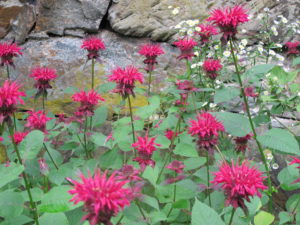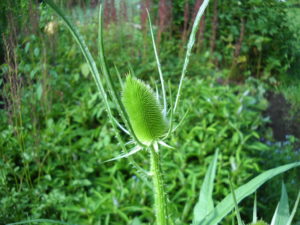When Good Flowers Get Out of Control
Every garden has a few thugs. Nice flowers with handsome blooms that somehow get too rambunctious and take over. They can choke out other plants as easily as weeds. That happens, in part, because we are reluctant to pull them. In general, they have roots that extend and send up new shoots. Let’s look at a few.
I recently pulled up a lot of beebalm (Monarda didyma). That was tough for me to do because it is such a great flower, and it has not yet bloomed. But it had run roughshod over most of one large flower bed, and it had to be brought under control.
Beebalm likes morning sunshine and soil that does not dry out completely. There is also a native beebalm (Monarda fistulosa) that I’ve seen wild in the Mid-west and Rockies. It is shorter, and has pale lavender colored flowers. It does well in hot, dry locations. Our garden beebalm comes in six or more colors from purple to pink – but it does best out of the hot afternoon sun. It sends roots up to a couple of feet, and because it is tall, it can shade-out and out-compete other flowers. As the Red Queen in Alice in Wonderland pronounce, “Off with her head!”
For removing any plant with extended roots, I like the CobraHead weeder. It is curved like a single steel finger, and can be used to loosen the soil under and around weed (or thug-like flower) roots. I gently tug on the flower stem, while loosening the roots. Beebalm, like most plants with long roots, has nodules in the roots. If you break the root, new plant stems will grow from a nodule.
Another difficult plant is Obedient Plant (Physostegia virginiana). What a funny name for a plant that is not the slightest bit obedient. Its roots are problematic because they break so easily, more so than any other plant I know. They send down a tap root that breaks off, even if you have loosened the soil. And it can take over a garden in just a season! I no longer allow it in any of my garden beds, but have moved some to the edge of the woods where deep shade on one side, and lawn on the other, can control it.
All that said, Obedient Plant is a lovely cut flower. It has strong square stems (like mints), and for me it grows up to 5 or 6 feet tall. It lasts well in a vase, with pink or white spikes of many small flowers. I had it in full sun in rich, moist soil, and it ran like crazy!
There is a form of Obedient Plant that has green and white leaves, and it is much more obedient! Like any variegated-leafed plant, this one has less vigor because it has less green chlorophyll to make the food that feeds the roots and flowers. I grow this one, though I find I often need to stake it to keep the flower stems from flopping over.
Another potential thug that I allow in my garden is common teasel (Dipsacus fullonum). Hated by corn farmers in the Mid-West as an invasive weed, it spreads by seed, not root. It’s a biennial. The first year of its life it does not flower, but produces distinctive long, light-green leaves (often with little wart-like bumps) in a low rosette. The second year it sends up a flower stalk up to 6 or 7 feet tall, and produces a seed head that is like a piece of sculpture.
Individual teasel flowers are very small and a light purple, but they don’t all appear at once. Bees love them! The seed head is very showy, a 2-inch spiny extravaganza that looks great in a vase as a cut flower, or later as a dried flower. I wear leather gloves to pick it, and then rub off the spines on the stems for use in vases.
The key to controlling teasel is to learn to recognize and pull the first year plants. That, and picking the stems with flowers before they distribute seeds. I suppose I will get e-mail telling me how stupid I am for allowing this thug in my garden, but I have been able to keep it under control – and I introduced it 20 years ago! Don’t introduce it to your garden unless you can pay attention to it, and keep it controlled.
Sometimes we make mistakes. We see a well-controlled plant blooming in its pot and buy one (or more). We put it in the garden, and only later decide that it has some bad qualities. It has taken me a long time to realize that it’s great to recognize that a plant is not for me, and then be able to dig it up and toss it into the compost.
I recently needed space for a new plant, and decided that I did not like my Siberian Bugloss (Brunnera siberica). I bought it because I have another species of Bugloss (B. macrophylla) that I like a lot. ‘Jack Frost’ Brunnera has lovely small blue flowers in spring and low green and white leaves all summer. But the Siberian relative does not stay in a compact mound, and is a bit floppy. So I yanked it in favor of something new.
Call me fickle if you wish, but I have a limited amount of garden space, and I reserve the right to remove any plant that does not, at least occasionally, cause me to say with glee, “I love that plant!”
Read Henry’s twice-weekly blog posts at https://dailyuv.com/




